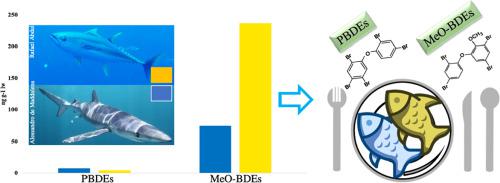Science of the Total Environment ( IF 8.2 ) Pub Date : 2021-05-18 , DOI: 10.1016/j.scitotenv.2021.147820 Dhoone Menezes-Sousa 1 , Mariana Batha Alonso 1 , Ana Carolina Pizzochero 2 , Danielle Viana 3 , Pollyana Roque 3 , Fábio Hissa Vieira Hazin 3 , João Paulo Machado Torres 4

|
Polybrominated diphenyl ethers (PBDEs) and their methoxylated analogues (MeO-BDEs) are widely distributed in the environment. The main concern about the presence of PBDEs and MeO-BDEs in fish is due to their potential endocrine disruption effects in the specimens, and their potential risk to the health of human consumers. Considering these concerns, the goal of this study was to investigate the occurrence of PBDEs and MeO-BDEs in muscle tissues of blue shark (BSH), Prionace glauca, and yellowfin tuna (YFT), Thunnus albacares, caught in the Equatorial Atlantic Ocean (EAO), North-eastern Brazilian waters, and to evaluate the potential risk of human exposure by consumption. Muscle tissues of YFT and BSH were extracted using a Soxhlet apparatus and an Accelerated Solvent Extractor (ASE), respectively. PBDEs and MeO-BDEs were analysed by GC-NCI-MS. Concentrations of PBDEs ranged from not detected (nd) to 10 ng g−1 lipid weight (lw) in YFT muscle samples, while PBDE levels in BSH muscle samples ranged from <LOQ to 34 ng g−1 lw. Regarding MeO-BDEs, the concentration ranged from 55 to 578 ng g−1 lw and from <LOQ to 263 ng g−1 lw in YFT and BSH muscle samples, respectively. MeO-BDE congeners contribution in both YFT and BSH indicated a predominance of 2′-MeO-BDE-68, which is associated to the sponges or sponge-microbiota metabolites. ∑PBDE were statistically similar between YFT and BSH, as well as observed for ∑MeO-BDE. PBDEs and MeO-BDEs in YFT and BSH represent a low potential risk of human exposure through the consumption of edible tissues. Further studies are necessary for a complete assessment of human safety and species conservation.
中文翻译:

与MeO-BDEs相比,赤道大西洋中上层捕食者发现PBDEs含量低:蓝鲨和黄鳍金枪鱼中溴化二苯醚的分析
多溴二苯醚(PBDEs)及其甲氧基化类似物(MeO-BDEs)在环境中广泛分布。对鱼类中多溴二苯醚和甲基二苯醚的存在的主要关注是由于它们在标本中具有潜在的内分泌干扰作用,以及它们对人类消费者健康的潜在风险。考虑到这些问题,本研究的目的是调查蓝鳍金枪鱼(BSH),白on(Prionace glauca)和黄鳍金枪鱼(YFT),金枪鱼(Thunnus albacares)的肌肉组织中PBDEs和MeO-BDEs的发生情况。捕捞在巴西东北部水域的赤道大西洋(EAO)中,并通过食用来评估人体暴露的潜在风险。YFT和BSH的肌肉组织分别用索氏提取器和加速溶剂提取器(ASE)提取。通过GC-NCI-MS分析了PBDEs和MeO-BDEs。在YFT肌肉样品中,PBDEs的浓度范围为未检测到(nd)至10 ng g -1脂质重量(lw),而在BSH肌肉样品中,PBDEs的浓度范围为<LOQ至34 ng g -1 lw。关于MeO-BDEs,浓度范围为55至578 ng g -1 lw和<LOQ至263 ng g -1在YFT和BSH肌肉样本中分别占lw。MeO-BDE同系物在YFT和BSH中的贡献表明2'-MeO-BDE-68占主导地位,这与海绵或海绵微生物群代谢产物有关。YFT和BSH之间的∑PBDE在统计上相似,并且∑MeO-BDE的观察到。YFT和BSH中的PBDEs和MeO-BDEs通过食用可食用的组织而具有较低的人体暴露风险。为了全面评估人类安全和物种保护,有必要进行进一步的研究。











































 京公网安备 11010802027423号
京公网安备 11010802027423号